Puppies have a lot of hyper energy and very short attention spans.
They are also infinitely curious and want to put everything that they see in their little mouths. This can make puppy obedience training something of a challenge.
When it comes to puppy training, we want to get our puppy to repeat good behaviors, and stop bad behaviors. The more a puppy practices a behavior, the more likely she will repeat it. Therefore, by encouraging good behaviors, we ensure that she will have a good repertoire of people friendly actions to draw upon when she grows up.
Here, we deal with the 3 primary elements of puppy obedience training –
- How to communicate consistently and effectively with a puppy.
- How to encourage good puppy behaviors.
- How to discourage bad puppy behaviors.

1. How to Communicate with Puppy

The first two words I teach my puppy are “Yes” and “No”.
“Yes” is used to mark a desirable behavior and “No” is used to mark an undesirable behavior.
Yes is usually followed by a positive consequence (e.g. a food reward, affection, toys), and No is usually followed by a negative consequence (e.g. withdrawal of attention, timeout).
In fact, we do not need to use the words “Yes” and “No”, and can pick whatever mark-words we want. The best mark-words are unique, and do not frequently come up in normal conversation. This helps to prevent confusion with our dogs.
For my dogs, I use Ack-Ack as a no-mark and Good-Boy or Good-Girl as a yes-mark.
- When my puppy does something good, I say “Good-Girl” and present her with a small treat reward.
- When my puppy does something bad, I say “Ack-Ack” and redirect her into doing something positive.
Consistency is very important while communicating with our dogs. We want to stick to the same yes-mark and no-mark.
In addition, we also want to establish very consistent rules and a fixed routine. This helps our puppy understand what is expected of her, as well as what she can expect from us.


One of the first things that I do with a new puppy, is set up a fixed routine. My puppy schedule includes playing time, training time, walking time, feeding time, and the ever important sleeping time. I try to keep the schedule consistent, so that each of these activities happen at around the same time every day.
Keeping a fixed schedule is good for me, and good for Puppy. It allows me to be more efficient about getting things done, and it sets aside some me-time while Puppy is sleeping and resting in her crate.
It also helps get a puppy accustomed to a new environment, without being overly stressed. In the beginning, everything is new, foreign, and possibly scary for a new dog. A fixed schedule helps to reduce stress, increase trust, and quickly integrates her into the existing family rhythm.
Similarly, a consistent set of rules will help to avoid confusion, and hasten the puppy learning process.
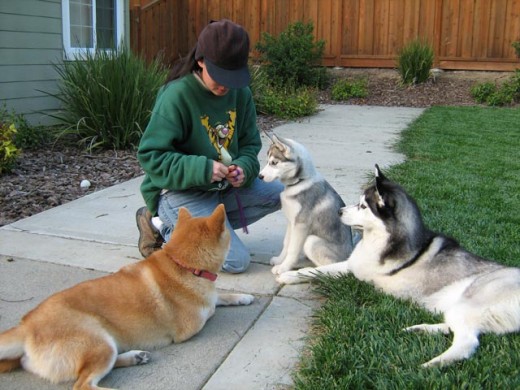
2. How to Encourage Good Behaviors
Puppy obedience training and even adult dog training is centered around two key areas-
- How to encourage and get puppy to repeat good behaviors.
- How to discourage and get puppy to stop bad behaviors.
It is important to recognize though that what we see as good and bad behaviors may not coincide with what our dog considers to be good and bad behaviors.
Dogs, even puppies, think for themselves and have needs of their own.
Therefore, we want to use our newly established communication system to teach our puppy what is good and bad for us. In addition, we must also motivate our dog so that she actually cares about our human values, which very likely, make little or no sense to her.


We encourage good behaviors by using the yes-mark, as soon as our dog finishes doing something good.
For example, when our puppy finishes doing a Sit we say “Good-Girl!” and then present her with a reward. The yes-mark is very helpful in training because it allows us to immediately mark the behavior that we want to reward.
To effectively train our puppy, we want to clearly indicate which action she is being rewarded for. If we wait too long, she will have moved on to something else, and we may inadvertently reward the wrong behavior.
Therefore, quickly use the yes-mark as soon as our dog finishes a good behavior. Then, we can take more time to present Puppy with her reward.

3. How to Stop Bad Behaviors
When it comes to stopping bad dog behaviors most of us think of applying a physical punishment, for example spanking the dog, jabbing the dog with our fingers, or giving the dog a collar correction.
These techniques apply pain to the dog, at which point the dog may stop her current behavior in order to avoid further pain and stress.
However, such pain based techniques are risky. If they are not executed with exactly the right force, timing, and redirection, they may cause more behavioral issues down the road; even aggression. It is especially risky to apply such techniques to puppies because of their young minds, and still developing bodies.
How then can we stop bad puppy behavior?

I have found that the best way to stop bad behavior is through the control of resources. *We* naturally control everything that a puppy wants, including food, toys, freedom, affection, and play.
To encourage good behaviors, we motivate our puppy by giving her something that she wants.
To discourage bad behaviors, we motivate our puppy by taking away something that she values, for example her freedom, or our attention and affection.
Note – This does not mean that we should tease our puppy and take away food while she is eating, or forcibly remove a toy that she is playing with. Doing so can encourage food aggression or resource guarding behavior.
What works best is to withhold something that my puppy wants, but does not yet have. Another possibility is to take away a privilege, such as withdrawing my attention or restricting her freedom.

When my puppy bites at my hands, I give her a no-mark (Ack-ack) and then redirect her to do something else, for example, chew on a toy. If Puppy redirects, I give her a yes-mark (Good-Girl), and reward her with something that she really wants, such as a yummy treat.
If Puppy ignores the no-mark and continues to bite at me, I withdraw my attention by standing up, folding up my arms, and turning away from her. In this way, she loses a valued play-mate, and no longer gets to engage in something fun.
If Puppy escalates her behavior and starts to jump on me or bite my clothes, I take away an even more important privilege; her freedom. I do this by calmly saying Timeout, and then taking my puppy to a boring but safe timeout area.
Puppies often bite at us to initiate play or to get our attention. We can effectively stop puppy biting by teaching her the following-
- Biting = No attention and no play,
- No biting = Attention, play, and treats.
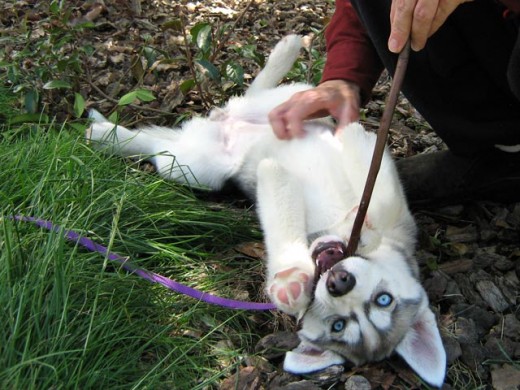
How to Train a Puppy
To stop bad behavior, I have found that it is important to –
- Start by redirecting Puppy into doing something positive. In this way, we turn a negative situation into a positive one. We not only get our dog to do what we want, but also teach her that following our commands, is the fastest way to get to her heart’s desires.
- Make the punishment suit the crime. I always start small and give my puppy many opportunities to choose a path for success. If she continues or escalates her bad behavior, then I slowly escalate her punishment.
- Stay calm at all times. Puppies have high energy and are easily distracted. If we get angry or frustrated, we will only inject more bad energy into an already volatile situation. This will likely cause our puppy to lose focus, become more hyper, and behave in an even more erratic fashion. If we want our dog to be calm, we must stay calm ourselves.
- Set Puppy up for success. Carefully manage our puppy and only expose her to situations that we think she can handle. For example, start by introducing her to new objects that are not moving, then slowly move on to moving objects, then objects that move and make noise, and so on. Start small and slowly move up to bigger things. The more successful a puppy is, the more confident she will become, and the more balanced she will be when she grows up.
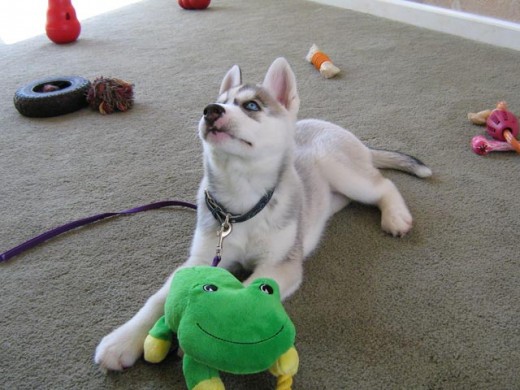
Goal of Puppy Obedience
The goal of puppy obedience is to learn how to communicate with our puppy, and teach her how to live well and harmoniously with us.
Obedience training can also help to protect our puppy from inadvertently harming herself and others, or from engaging in activities that may be detrimental to her health (e.g. over-eating, walking on glass).
Obedience training is *not* for acting out our anger, or venting our frustrations when our puppy poops on our furniture, eats poop, and spreads garbage all over our expensive designer couch.
We are not perfect, and Puppy is not perfect. In the initial stages, mistakes will be made, some of which may lead to chewed up designer shoes, scratched kitchen cabinets, and stained carpets. However, this is all part of the learning process.
Puppies, and indeed all dogs do not perform bad behaviors just to piss us off, make us angry, or exact revenge.
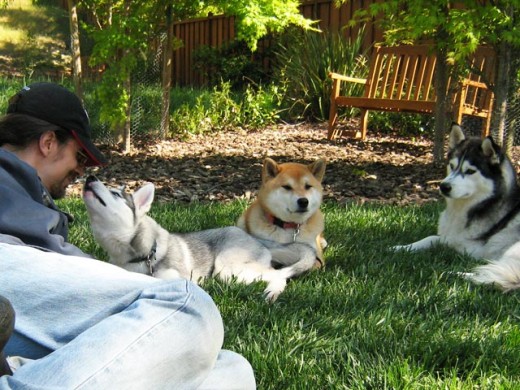
Puppies Acting Badly
Puppies or dogs act badly because …
- They do not know that something is bad because we did not teach them properly.
- They were stressed and started chewing, digging, or even pooping in order to relieve that stress (displacement behaviors).
- They felt threatened and thought it was necessary to protect themselves, or their belongings.
The key to puppy obedience training is in learning to see things from our dog’s point of view.
Once we understand what motivates our puppy, we can prevent undesirable actions and encourage desirable ones.
Dogs spend a lot of time observing us, understanding what makes us tick, and making us happy. The least that we can do, is try to return the favor.
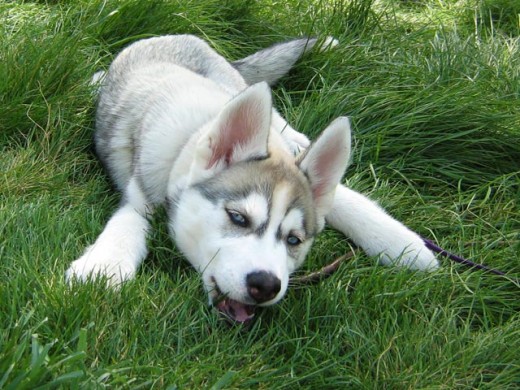
What do you do with a husky puppy during night time? We have a 9 week old and we are working on crate training but he cries and howls all night in it and poops in his crate only at night. I don’t want to leave him to wander and destroy the house but also don’t want the crate to be traumatic.
ooo, and another question regarding routines:
– how often do you bath and groom?
– how much time do you spend on the units: playing time, training time, walking time, exercising time
Thanks agaign and hope to hear from you soon 🙂
Maria
HI ShibaShake,
My name is Maria and my Husky is Miss White. She is now 7 months old and I have to say that I am pretty happy with her behavior and obedience… up to a week ago.
She started vandalizing around the house. At first I thought that the room she used to stay for max 4 hours alone is maybe not enough and maybe seen as a punishment, but then after leaving another door open – she destroyed the cat tree 🙁
I always leave her 2 big full kongs, a piece of wood, a bone or skin to chew on. But still….
We go out in the morning for minimum of 30 minutes, then before I leave for work is feeding time (kongs). My roommate goes out with her again by midday. Then again after work I go out with her for 1 hour, play and train almost all the time. I do not let her off leash (during the week), because due to the winter season it is dark and I am scared. I try to keep in touch with other dogs so that she has a better playmate but it is hard to meet other dogs every day. Mostly on the weekend I let her run free. We sometimes have longer go outs than the 5 minutes pro month regulation.
Do you have any suggestion on what I can approve in our daily routine? Does the routine have to be the same also on weekends? Can you recommend any toys and indoor games?
Thank you in advance for sharing your experience and advice.
Best regards,
Maria
Hi
I have a tow year old male Husky and want to introduce a female Husky puppy as a companion. What is the best way to introduce these tow as I do not want to harm the pup. Your advice will be greatly appreciated.
Some of my experiences with introducing a second dog –
https://shibashake.com/dog/second-dog-introducing-a-second-dog
When my puppy was still small, I kept a soft-lead on her so that she is next to me. In this way, I can direct play and stop play when things get too rough.
I have a 1 year old husky and then just go a 7 week old puppy, they are getting along great! However, the 1 year old thinks she is just a ball of fluff and wants to play with her really hard. It makes us a little nervous because he like runs at her and sometimes paws her because he wants to play, we do not want her to get hurt because she is so little. Is there a good way to help with this?
Congratulations on your new puppy! Yeah, I have more rules during puppy time. I find that it also helps to have my puppy on a lead so that she is close to me and I can make sure my other dogs aren’t too rough. Here are some of my play-time rules –
https://shibashake.com/dog/second-dog-introducing-a-second-dog#play-time
I recently (four days ago) got a three month old Siberian husky puppy named Ace who I absolutely love but he isn’t like any other husky I’ve read about. He is very mellow and doesn’t get excited over treats which makes him very hard to train. He’s doing really good on a leash and around my other animals and has partially learned to come to me when I call him. But I don’t know how I can efficiently train him without a good solid reward. Have you come across any other huskies like this?
What you want to do is find something he is interested in for example a toy and encourage him with that also if he is mellow use that thing and get him outside and running
We have a 6 month old husky named Yeti. She is a great dog but she nips at my wife and also jumps on people. Is this normal?
I have been researching training methods all day. I have a 5lb 8 week old shih tzu. I am considering training him to “go indoors” so I dont have to worry about him holding it all night or while im at work. I have looked up “litter boxes” and matts you can put puppy pads under. I am wondering what the pros and cons could be of training the dog to go inside rather then outside will be? I am very overwhelmed by all the methods and what is best for my dog! I was hear that the dog training tips from justin boldoni on facebook work greats and I think I want to try it out.
It is but that is not good what you want to do is tell your dog that is not good or if it is a puppy Yelp because it show that it hurt you then redirect the him/her and if he keeps it up tell him he not behaving correctly put him in his crate
i have a husky that looks exactly like yours, the one with the blue eyes 🙂
I currently have a 5 month old husky/malamute puppy and she is a night mare. We have been consistently training her since day one but she was sick for the first 2 months we had her so we used puppy pads since she was too sick too walk outside. Now she is making no progress on housetraining even though we have gotten rid of the puppy pads. I get up every two hours at night to take her out side and she will go but then two hours later there is poop and pee on the floor. Sopmetimes she will even do it right in front of me on the floor even while I am saying no. I make sure to watch her and keep a good eye on her but she doesn’t seem to care. Any suggestions
Hi,
I have a 3 month old husky and she has been sick since we got her. Someone told me to get bells that hang on the door and every time you take your puppy outside take her/his nose and ring the bells and say potty outside ( yes it sounds crazy), when you come in let the puppy ring the bells again and say good girl/boy potty outside. My puppy now rings the bells when she has to go. She still goes in the house at times if she doesn’t get to the door in time but it has gotten a lot better.. I hope this helps you .